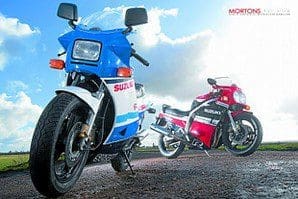
Imagine, if you will, two design teams at Suzuki working in complete isolation. Each has been tasked with designing and building the best road-going motorcycle they possibly can. Both teams working late into the night fuelled by strong black coffee. Both working with cutting edge technology. And what a pair of bikes they came up with.
Without knowing the story behind the bikes it seems entirely feasible that this could be the case; with one team wanting to go down the two-stroke route to produce a 500cc machine that to all intents and purposes is a direct replica of their incredibly successful Grand Prix machine.
The other team eschewed the company’s two-stroke heritage and decided to look forward into a four-stroke future with an aluminium-framed, water-cooled 16-valve inline four. One designed the last great big two-stroke, the other designed the bike that changed motorcycling forever.
While it is a nice idea that the two design teams were working in isolation, the reality is that the RG500 was initially planned in 1983 but development of the GSX-R750’s new engine technology meant the RG500 was actually delayed in getting to market. So, ultimately, both bikes appeared in the same year; the old guard and the new. Of course, we didn’t realise then that the two-stroke machine was the outgoing technology. One was a bike that would become a racer in its own right and the other, while a copy of a racer, was purely a road bike. Most telling of all was the fact that Suzuki produced a race kit for the GSX-R but didn’t produce one for the RG. They knew where the future was headed.
This year is the 25th anniversary of both bikes. Unlike the RG500, the GSX-R750 name is still carried by Suzuki’s sports 750 (incidentally, Suzuki is the only factory still be producing a sports 750). That’s an incredible lineage.
After so many years, there is bound to be a certain amount of rose-tinted viewing of these bikes, especially for those who maybe owned, or rode, one back then.
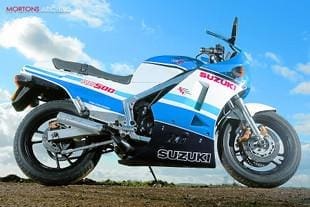 RG500
RG500
An RG500 is something of an experience (I’ll admit up front that this is my own bike), and it’s not to do with the Grand Prix pedigree. It’s the riding position; the seat position is low and the bars, despite being fitted under the top yoke, feel high compared to a modern middleweight machine and, accommodation aside, it’s the dash layout that tells you what is most important about this bike. Suzuki mounted the rev-counter smack in the middle of the dash, with the speedo and temperature gauges playing bit parts to either side.
With four strong springs to overcome, the RG’s throttle feels heavy, especially if you’ve been riding modern bikes in recent years. There’s no electric start and the bike needs to be in neutral to start – you can’t hold the clutch in as this disengages the kickstart. There’s a fair amount of compression to kick against and the bike only responds to a decent kick, otherwise it won’t fire into life. A couple of strong kicks, and the bar mounted choke pulled towards you, are all it takes when the engine is cold. And what a noise you’re greeted with. The exhaust note is muted at tickover but, once the engine is warm, blipping the throttle results in a delicious crackle out of the four silencers. Then there’s the smell. It can’t be good for you but the smell of burnt two-stroke hydrocarbons is one of the nicest aromas in motorcycling.
Select first gear, give it a few revs (the rev counter doesn’t start counting until after 3000rpm, the same as on the GSX-R) and slip the clutch; we’re away. The RG now feels tiny. But it’s the handling where the RG really shows its age. The 16-inch front wheel and skinny 120/90-section rear tyre make the bike steer quickly and slightly nervously and it doesn’t take much body movement to affect your line. This is no sit back and relax Sunday cruiser.
At low and medium revs the engine is docile and there’s a decent amount of torque for normal riding; this isn’t a bike that can’t be ridden out of the power. Wind the throttle open and as the revs pass from 5000-6000rpm the motor takes a deep breath (the lull before the storm some might say, but I won’t because it’s a cliché). Then from 6000rpm through to 9500rpm the motor unleashes its two-stroke kick. In first gear the front wheel snaps up quickly and in second it’ll gently rise a couple of inches. This is what riding a two-stroke is all about; that white-knuckle adrenaline ride that can only come from a light-switch power delivery. Let the motor keep pulling through the gears and it’ll do a genuine 140mph, showing almost 150mph on the white-faced speedo (as long as you have the jetting right, otherwise it’ll nip up and leave you white-faced too at the side of the road).
While the handling is old-fashioned, the motor dishes up excitement. And it’s this that really makes the bike. If it didn’t sound like it does and go like it does then there’d really be no fuss to make about the RG. But it does and that’s why there is such a fanatic following.
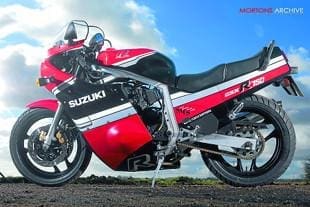 GSX-R750
GSX-R750
However, the GSX-R750 has shrugged off the years. First of all the riding position is less cramped and more comfortable. The bars are set well forward so you’re stretched out over the tank and the large fairing gives lots of protection from the wind. There’s something about being tucked behind the GSX-R’s fairing that makes me feel like an endurance racer. I can just imagine the twin-headlights searing their way along the Mistral straight. The slab-side moniker has stuck with these early GSX-Rs but there’s no denying that it’s a handsome bike.
Starting the four-stroke is less of a faff than with the RG; just pull out the carb-mounted choke, press the starter and the oil-cooled four spins into life and settles to an easy burble. As with the RG, the rev-counter doesn’t start counting until 3000rpm, so setting a tickover speed is more guesswork than science.
The GSX-R’s suspension is surprisingly well damped, giving the ride a plush quality that escapes the RG and the 18-inch wheels (and the slightly wider tyres) make the handling much more planted and predictable. The GSX-R doesn’t get it all its own way though, the extra weight is noticeable too after the skinny RG. Although this was much lighter than the GSX and other leviathans it replaced it feels porky after riding the RG.
Both bikes share similar brake setups and they both give good braking considering their age. Then again, these were the cutting edge of sports bikes at the time.
‘Both bikes have 160mph indicated on their speedo but where the RG’s rev-counter has a 10,000rpm redline, the GSX-R is allowed to keep on revving to 11,000rpm’
The GSX-R’s clocks are even more minimalist than those on the RG. With the air/oil-cooling there’s no need for a temperature gauge so the rev-counter sits proudly above the speedo right in the rider’s field of view. Both bikes have 160mph indicated on their speedo but where the RG’s rev-counter has a 10,000rpm redline, the GSX-R is allowed to keep on revving to 11,000rpm.
Open the throttle wide at low revs and the flat-slide carbs (fitted with individual filters on this bike) struggle to fuel the engine. Ease off a little and it starts to pickup well. Give it full throttle, once the revs allow, and the needle takes a brief pause at 6500-7500rpm and then shoots around the dial. The pick up in power is two-stroke like and in this respect the GSX-R is very similar to the RG; both can be ridden at low speeds quite easily but they need revving hard to get the best out of them.
Suzuki’s original claims of 95bhp for the RG and 106bhp for the GSX-R were wildly optimistic. On a typical Dynojet dyno a GSX-R will make around 90bhp and the RG will just about manage to pump out 75bhp. But both bikes respond well to tuning. An RG with minor mods (air filter, jetting and ignition advancer) will make 85-90bhp but can be made to really fly with over 140bhp available if Mark Dent at Performance Fabrications is allowed free rein. The GSX-R will pump out in excess of 110bhp with little more than cams, exhaust and a Dynojet kit for the carbs.
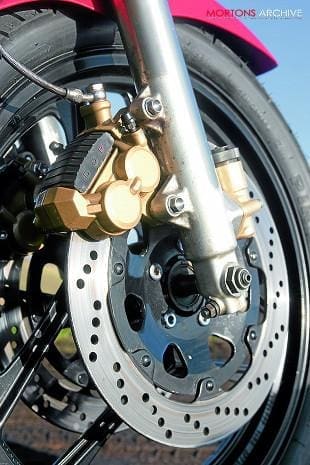 Buying A GSX-R750
Buying A GSX-R750
While I might be generalising to a certain degree, a large majority of GSX-R750s have been crashed over the years and a fair proportion of those were made into streetfighters, stripped of their fairings and given high and wide bars. This means that finding a GSX-R in good condition these days isn’t impossible but it does take a degree of patience because a standard bike is reasonably rare. These early slab-side GSX-Rs are good value for money. A bike that’s had little, or no, restoration work but is in reasonable condition can be had for around £1200-£1500. Little money for what looks set to become a future classic.
There’s very little that goes wrong with the GSX-R other than general wear and tear (although look for oil leaking from the cam cover bolts as owner-mechanics often overtighten them and strip threads).
The engines in early GSX-Rs were very popular with sidecar racers in the 90s because of their lighweight and good power output. So many bikes have been pulled apart to donate their powerplants. Buy the best condition bike that you can afford and budget to replace chassis bearings, tyres, chain and sprockets. Many bikes will have had aftermarket exhausts fitted along with individual foam or gauze filters. This in itself causess running problems because the flatslides on the 1985 GSX-R are tricky to set up for individual filters without getting flat spots in the midrange (look for a bike with the original airbox). Original silencers are almost impossible to find; they rot from the inside then the baffles fall out.
Buying an RG500
The RG500 is a completely different buying proposition to the GSX-R. The bike was only made from 1985 to 1987. A three year production run is tiny, effectively making the bike a classic from the word go. In the late 90s a decent RG could be had for £2000. Today you’ll pay the same money for an engine in need of a rebuild. A tired bike in need of a rebuild will cost in the region of £2500-£3000. A running bike in need of little work will often fetch £5000. At the 2006 CMM Stafford show an RG with 28 miles on the clock fetched a heady £9775.
Buying prices aside, the RG has its own quirks that need to be taken into account when looking at a prospective machine. The main issues relate to the gearbox and whether the bike has been stood for a long period of time. Firstly, the gearbox is relatively weak and second gear is known to jump out and it can lead to destruction of the gearbox and a big hole in the engine cases. Make sure that any bike you’re looking at buying has had the modified undercut gears fitted and that it doesn’t jump out of gear when accelerating hard (in any gear). It’s not too big a job to replace any gears because the cassette gearbox only takes 20 minutes to whip out.
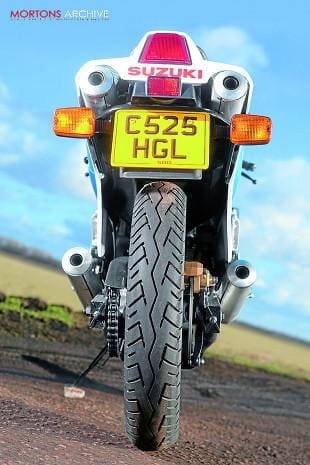 Secondly, due to the nature of the engine’s disc-valve design, two of the inlet ports are always open at any one time when the engine isn’t running. If a bike has been stored without being run for many years not only will the crank seals be dry and brittle, a light coating of rust can form on the main bearings and big ends. When the engine is started, the rust is ground away to leave a rough surface and it doesn’t take long for this to wear excessively. So beware an advert stating that the bike has been dry stored for a long period; it’ll need stripping.
Secondly, due to the nature of the engine’s disc-valve design, two of the inlet ports are always open at any one time when the engine isn’t running. If a bike has been stored without being run for many years not only will the crank seals be dry and brittle, a light coating of rust can form on the main bearings and big ends. When the engine is started, the rust is ground away to leave a rough surface and it doesn’t take long for this to wear excessively. So beware an advert stating that the bike has been dry stored for a long period; it’ll need stripping.
Ownership
While both of these bikes are similar in many ways, they are very different as ownership prospects. The RG is a fickle yet exciting toy that drinks fuel and has an appetite for expensive two-stroke oil. It could hardly be described as an everyday riding prospect. The GSX-R on the other hand is far less fussy and could easily be used as an everyday bike. They both have pedigree. Ultimately, the choice is up to you. Suzuki has to be applauded for producing two bikes that can still get the heart racing, stir the soul and still make you smile after 25 years.



